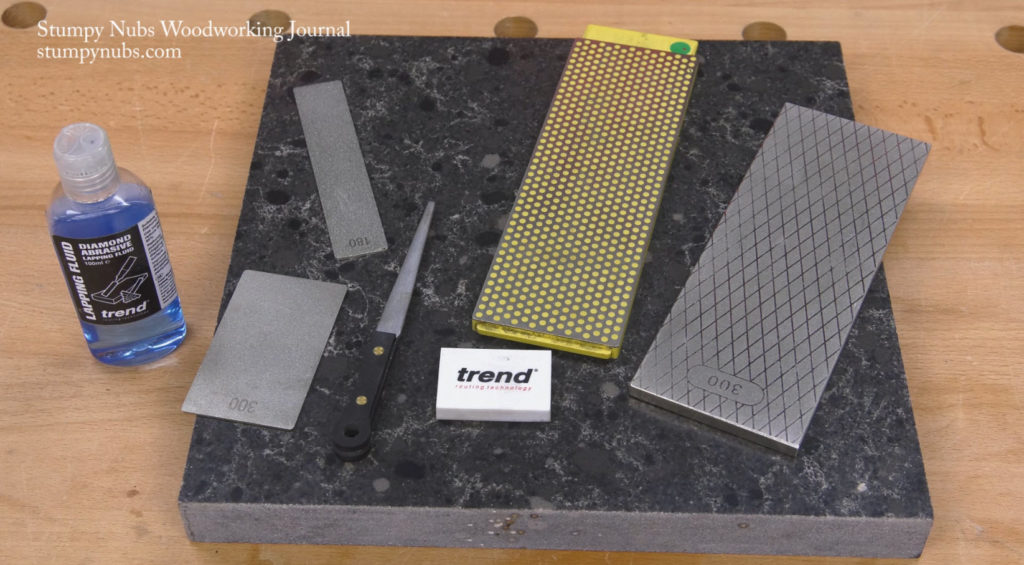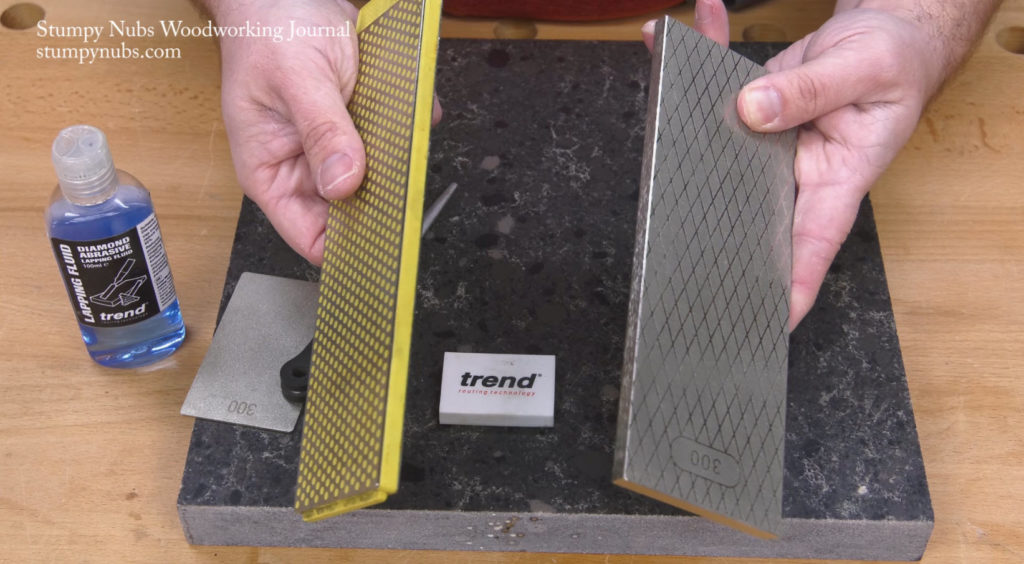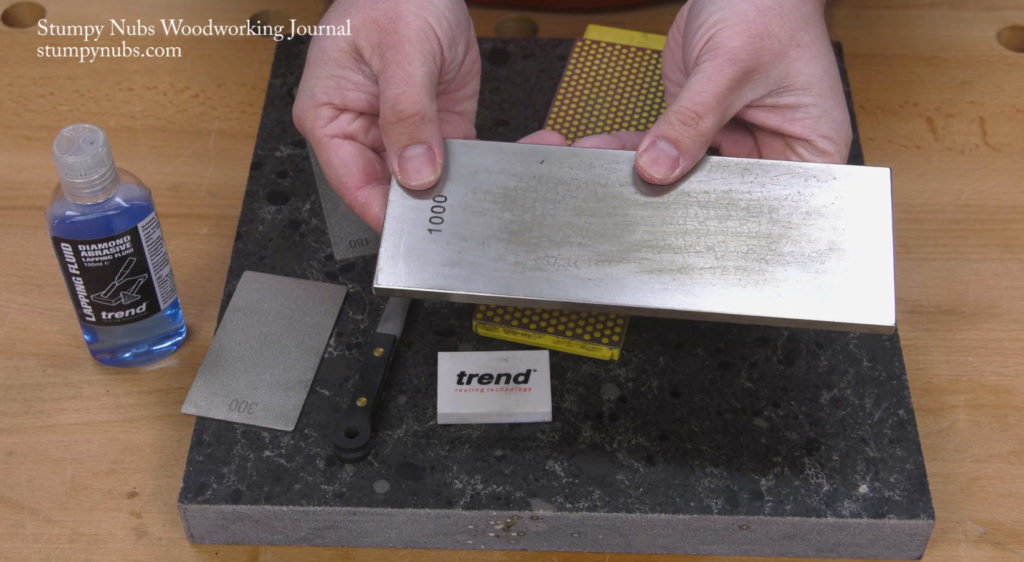How To Use A Diamond Sharpening Stone
How to cull the correct diamond stone in a world where you lot get what you pay for.
Notation: Ringlet to the bottom of this folio to watch a video version of this tutorial and to find links to things mentioned in the video.
At showtime, diamond sharpening stones may seem pretty straightforward- flat plates with grit on them. They're simply human being made stones, right? Actually, there's more than to them than you may realize. And it's important that you lot empathise some basic facts well-nigh diamond stones if y'all hope to get great results without wasting a lot of your hard-earned money.
Hither are some answers to common questions regarding how diamond stones piece of work, how they are made, and how you can cull the correct one:

Why are diamond stones so popular?
I think that's a matter of opinion. But for me it comes downward to two things: They are like shooting fish in a barrel to maintain, and they work fast. Unlike traditional stones, a diamond plate doesn't become "dished out" as you use information technology. That means you won't have to re-flatten information technology between uses, equally you would a traditional water or oil rock. And since diamonds are i of the hardest materials on earth, they cut steel very apace. They may even be used to sharpen carbide router $.25 and cutters.
Are those real diamonds?
All the stones I have always used are covered with human made "micro diamonds". There are a couple unlike processes that may be used to create them, but they mostly involve chemicals, gasses, carbon and heat. Diamonds are literally grown on a substrate in a special bedchamber. They are sifted to split up them by size and fastened to a plate for your sharpening convenience.
Practice the blazon of diamonds thing?
Some diamond stones are created with what are chosen "polycrystalline diamonds", while others utilize "monocrystalline diamonds". The surface of a polycrystalline diamond is covered with tiny points and sharp edges. These edges fracture during use, exposing new abrupt edges. This is dandy for very fine polishing pastes but not and then much for diamond sharpening stones considering every bit polycrystalline diamonds fracture, they become smaller. Suddenly your 300-grit stone becomes something entirely different. That'southward why high-quality diamond stones are made with monocrystalline diamonds. These are more expensive to produce, but they maintain their size and shape during use. It takes a very long time for this blazon of diamond rock to wear out.
Electroplating vs. adhesives- which are ameliorate?
The quality of your stone is merely as skillful as the adhesion between the diamonds and the substrate. Manufacturers of cheap stones merely sprinkle the diamond bits onto a layer of agglutinative. These stones may wait and even feel fine at commencement, simply they won't last. Good diamond stones are electroplated. A metal plate is dipped into a solution of heated nickel and diamonds, and so an electrical electric current is passed through the solution causing it to bond with the metal plate. This process embeds about two thirds of each diamond into the nickel layer. Like an iceberg, most of the diamond is locked below the surface, making it very hard to remove. Electroplated diamond stones take a far longer lifespan than those made with adhesives.

Are plastic plates as good every bit all metal plates?
For any sharpening stone to piece of work well for chisels and airplane irons, it must be perfectly apartment, and it must remain that way. To save money, many manufacturers attach their diamonds to a thin metallic plate, which is in turn attached to a thicker block of plastic. These plastic plates are molded, not machined. They are rarely flat. Other manufacturers attach their thin metallic plates to a thicker machined metal base of operations. Only frankly, that defeats the whole purpose. Non only do adhesives compromise the plate's flatness, simply moisture may seep between the layers over fourth dimension, introducing rust that can affect flatness or fifty-fifty cause delamination. A proficient diamond stone should be a unmarried plate of steel, precisely machined to better than +/- 0.001". (The procedure of electroplating the diamonds volition slightly subtract the level of flatness, so the plate itself should really be approx. +/- 0.0005" if you hope to achieve +/- 0.001" in the end product.) Only and so can you be sure that it volition be flat and remain so over time.
Should I utilise my diamond stone dry?
Some companies say you may use their stones dry out. While this will not harm the diamonds, it's rarely a good idea. Every bit textile is removed from your bract, it must go somewhere. A liquid lubricant will create a swarf that will comport the fine shavings away and so they won't clog upwards the tiny spaces betwixt the diamonds, which would quickly cause them to terminate cutting.
Should I utilize water on my diamond stone?
Some companies recommend h2o as a lubricant. I remember this is a bad idea, and I'thou not solitary in that theory. It is never a good thought to innovate h2o to metal unless you are certain you can get it completely dry every fourth dimension. This isn't easy. H2o is likely to remain deep in the grit which may seep into the nickel used to embed the diamonds. If moisture makes its way to the steel substrate it may atomic number 82 to corrosion and loose diamonds. This problem will be compounded if your stone is fabricated from two or more layers.
What near light oil, kerosene or WD-40?
Fine stones (grand grit) feature diamonds that are nigh 15 microns in size. Since about two thirds of the diamond is embedded in the rock the valleys left between the diamonds are merely about 5 microns deep. According its materials condom data canvas, WD-forty leaves a film of 17 microns. Needless to say, that is thicker than the valleys are deep. And so, while light oils similar WD-xl, 3-in-1 oil or kerosene may be fine for very course stones, they are likewise thick for fine grits. Using them volition reduce the stone'south effectiveness.

What diamond stones do you recommend?
I have get partial to the Trend stones (chapter link). They meet all the standards I laid out above Trend stones are a single piece of thick steel. They are machined to +/- 0.0005", the flattest in the industry. The monocrystalline diamonds are securely embedded with an electroplating process. They aren't cheap because they didn't cut any corners. Just even with daily utilize they will terminal about a decade, much longer in the boilerplate garage workshop, so the investment doesn't hurt so much. Now, I must admit that I personally know the guys at Tendency, and they are a sponsor of our website. But I was using their products before they were a sponsor. And I can honestly say that they work as advertised.
What grits do you recommend?
I apply a 300-grit rock to create a new bevel, and follow up with 1000-grit. Equally a concluding stride I use a leather strop with a polishing compound to finish the border. Why 300/1000? Considering those happen to be the two grits on my double-sided rock (chapter link). Frankly, information technology doesn't matter every bit much every bit yous think. 300 dust is dainty considering it works faster than 600, but it's not and so course that you have to spend all 24-hour interval on the 1000 dust to remove the 300 grit scratches. m grit is abrupt enough, particularly if you follow upwards with the strop. I know some people like to fuss over grits, and water stones may go into the tens of thousands. Just forest is an abrasive fabric. After a couple of strokes your twenty,000 dust edge is going to be worn downwards to yard or less anyhow. If 1000 followed past a low-cal stropping is abrupt plenty to shave the hair off my arm, it'southward abrupt enough to shave wood fibers.
Only one double-sided stone?
These things aren't cheap, why purchase more you need? Of grade, there are some great diamond accessories on the market for special applications, such as files and credit bill of fare hones (affiliate line). I apply them as needed. But most direct edged tools can exist sharpened with the single rock and strop.
What's the bottom line on diamond stones?
If you sharpen your tools by hand y'all may want to check into diamond stones. They require almost no maintenance and they cut steel fast. If yous practise decide to purchase diamond stones, insist that they be made with monocrystalline diamonds that are electroplated to the surface of a single piece of machined steel. No glue, no layering. Avoid using your stones dry out, stay away from water, and if your fine grits are cutting slowly information technology may be the type of lubricant y'all are using. Finally, you can get by just fine with a 300/1000 or like double-sided stone (chapter link) and a leather strop for simply virtually every woodworking tool.
LINKS WORTH CHECKING OUT:
(We may make a small-scale financial gain if you use these affiliate links)►
Trend 300/1000 grit stone: http://amzn.to/2nBdaq5
Trend lapping fluid: http://amzn.to/2nknjF8
Trend Tool & Bit cleaner: http://amzn.to/2dZkJl3
Trend Kit/C (for router bits, forstner bits, etc.): http://amzn.to/2nhNLi7
When you apply this link to visit our sponsor, y'all support the states►
Trend diamond stones: https://amzn.to/2XomWMi
Follow us on social media►
Instagram: https://world wide web.instagram.com/stumpynubs/
Twitter: https://twitter.com/StumpyNubs
Facebook: https://www.facebook.com/Stumpy-Nubs-Woodworking-Journal-305639859477973/
Source: https://stumpynubs.com/diamond-sharpening-stone-tutorial/

0 Response to "How To Use A Diamond Sharpening Stone"
Post a Comment